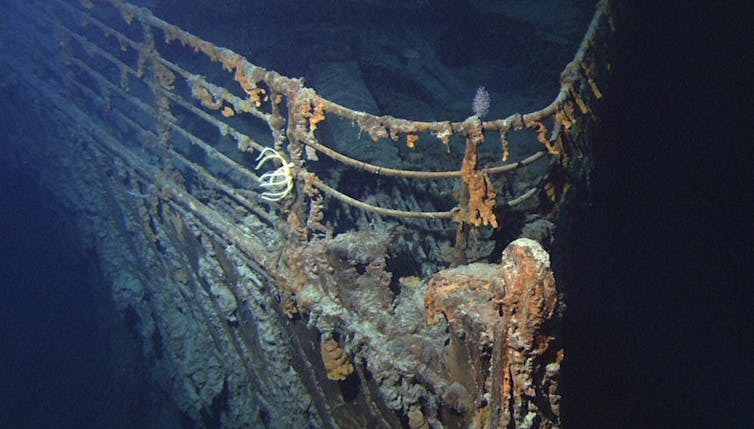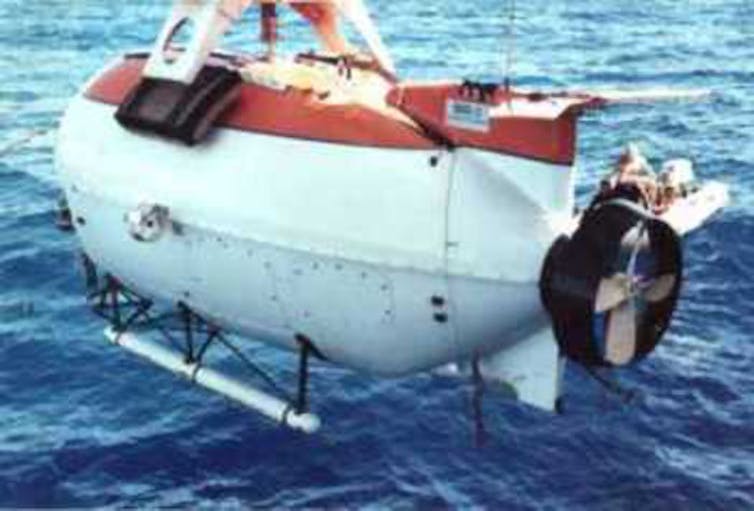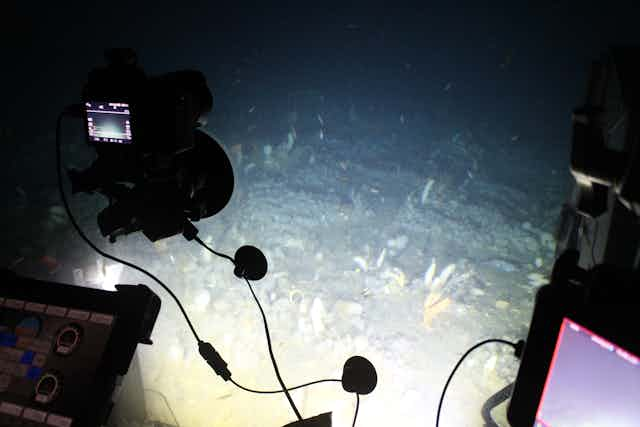The tragic death of five people when the Titan submersible imploded during its descent to the wreck of the Titanic has led some to describe deep-diving submersibles as inherently risky. But their history shows that this is far from the case.
Bathyspheres were unpowered submersibles lowered into the sea on a cable and used for pioneering dives in the early 1930s. Since then, submersibles have taken many more people into the deep ocean than the number of humans who have been into space. None of those submersible dives have previously experienced a catastrophic hull failure. The investigation of the Titan will now seek to understand why it was an exception.
Other vehicles had visited the Titanic multiple times. The Titan had a tubular design – rather than the usual spherical shape – and the hull was made of carbon fibre, a material not previously used on deep-diving submersibles.
Deep-diving submersibles are smaller than traditional submarines, and unlike submarines they are launched and recovered from a surface support ship. Although submarines have suffered implosions when damage or systems failures have caused them to sink beyond their much shallower depth limits, no submersible had imploded before under the huge pressures of the deep ocean.
Before the Titan, the only fatal incidents involving the occupants of submersibles occurred in the 1970s in shallow water. Fumes from an electrical fire overcame the occupants of a Japanese tethered diving bell at around 10 metres deep in 1974. Prior to that, the Johnson Sealink submersible became entangled on a shipwreck at 110 metres deep in 1973, and two of its four occupants died from carbon dioxide poisoning before it was recovered.
In 1970, the Nekton Beta submersible was salvaging a sunken powerboat, when it broke free from its lifting line and collided with the submersible, causing a leak that drowned one of the occupants.
Pushing the limits
When the wreck of the Titanic was discovered at 3,800 metres deep in 1985, submersibles had already been diving to greater depths than that for several decades. The first to do so was a bathyscaphe – a submersible suspended below a float, rather than from a cable like the bathysphere. It was called FNRS-3 and it set an overall depth record for the time, reaching 4,050 metres in 1954. It was followed by the Trieste, which dived 10,916 metres down in the Mariana Trench in 1960.
Since then, there have been at least 16 submersibles that have repeatedly taken people deeper than the Titanic in the past 69 years.

The US submersible Alvin made the first dives to investigate the Titanic in July 1986, followed by the French submersible Nautile in 1987. Nautile returned in 1993 and dived to the wreck 47 times in total.
Over a 14-year period starting in 1991, the two Russian Mir submersibles visited the Titanic wreck more than any other vehicle. These expeditions included filming the ship for director James Cameron’s movie Titanic in 1995.

The Mir submersibles were used for the first tourist dives to the Titanic, which began in 1998 and cost US$32,000 per customer at the time, equivalent to around US$69,000 today. Two people got married aboard Mir while it was diving on the bow of the Titanic in 2001, having won their dive tickets in a competition.
On their final dives to the Titanic in 2005, the Mir submersibles also filmed a live TV programme from the wreck, relaying images via a fibre-optic tether to their support ship and then ashore by satellite. Cameron presented the show, Discovery Channel’s Last Mysteries of the Titanic, from inside Mir-2 as part of the first broadcast from such a depth.
Today’s submersible fleet
The Mirs are now museum exhibits. But there are currently seven submersibles in service that can reach the depth of the Titanic and beyond. Six of them are owned by governments and used for deep-sea science. Three of these are Chinese, while the US, France and Japan have one apiece.
There is one very deep-diving submersible in private ownership: the Limiting Factor was built by Triton Submarines for Texan billionaire Victor Vescovo to pilot to the deepest point in all five oceans in 2019. It has since dived in more than a dozen deep-ocean trenches, including repeated dives to the ocean’s deepest point: the Challenger Deep in the Mariana Trench. Limiting Factor also dived to the Titanic five times in 2019. In 2022, Vescovo sold it to the Inkfish research organisation founded by US billionaire Gabe Newell, and it has since been renamed the Bakunawa.
All of the current submersibles that can reach the depth of the Titanic enclose their occupants in a spherical metal hull, as that shape helps to distribute pressure evenly across its surface. Those craft can only accommodate two or three people, as a larger spherical hull would be too big and heavy to launch and then recover easily from a support ship. The Titan had a tubular-shaped hull, splitting the traditional sphere and inserting a carbon fibre tube between its halves to make room for five occupants.

But hull shape isn’t the only consideration in investigating what happened to the Titan. The Aluminaut submersible of the 1960s, which was capable of diving to 4,500 metres, had an aluminium hull with a tubular shape that could carry seven people.
So the investigation will also consider the materials used in the Titan’s hull, including the carbon fibre that had not been used for that purpose before, and how the two titanium hemispheres and carbon fibre tube section of the hull were joined together.
In 2013, I dived aboard Japan’s Shinkai 6500 submersible to study undersea hot springs at 5,000 metres deep on the ocean floor. I would dive in that vehicle again if I had the opportunity -– not as any sort of risk-taking adventurer, but as a scientist safely going to work.
By analysing debris from the seafloor, the investigation of what happened to the Titan needs to examine why it is such an apparent outlier in the safety record of deep-diving submersibles.

